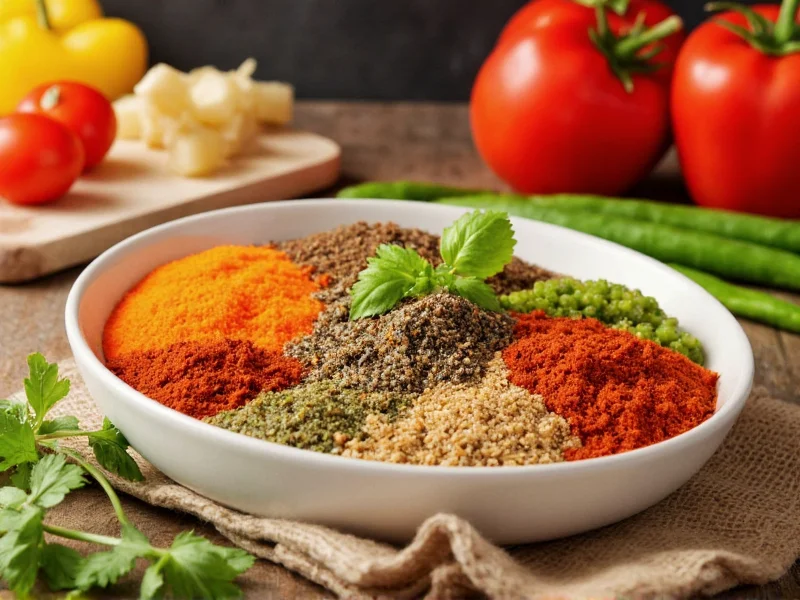Seasoning vegetables properly transforms simple produce into memorable dishes. Many home cooks struggle with bland vegetable preparations simply because they don't understand how different seasonings interact with various vegetable types and cooking methods. This comprehensive guide reveals the science and art behind perfectly seasoned vegetables, helping you elevate your everyday cooking with confidence.
Understanding Vegetable Flavor Profiles
Vegetables fall into distinct flavor categories that respond differently to seasonings. Recognizing these profiles helps you select the best seasoning combinations for vegetables. Root vegetables like carrots and potatoes have earthy, sweet notes that pair well with warm spices. Cruciferous vegetables including broccoli and cauliflower have slightly bitter compounds that balance beautifully with acidic elements. Nightshades such as tomatoes and eggplants offer umami richness that complements aromatic herbs.
Seasoning vegetables properly requires understanding not just the vegetable type but also the cooking method. Roasting caramelizes natural sugars, making vegetables receptive to bold seasonings, while steaming preserves delicate flavors that require subtler seasoning approaches. The timing of seasoning application—before, during, or after cooking—also dramatically affects the final result.
Essential Seasoning Principles for Perfectly Prepared Vegetables
Mastering vegetable seasoning involves more than just sprinkling salt. The foundation of effective vegetable seasoning rests on four key elements: salt for flavor enhancement, fat for carrying flavors, acid for brightness, and herbs for complexity. Understanding how these elements work together creates balanced, restaurant-quality results at home.
When considering the best herbs for roasted vegetables, remember that dry heat intensifies flavors. Robust herbs like rosemary, thyme, and oregano withstand high temperatures better than delicate herbs like basil or cilantro, which should be added after cooking. For steamed or raw vegetables, lighter herbs provide the perfect finishing touch without overwhelming delicate flavors.
| Vegetable Category | Recommended Seasonings | Best Cooking Methods |
|---|---|---|
| Root Vegetables (carrots, potatoes, beets) | Rosemary, thyme, garlic, cumin, smoked paprika | Roasting, grilling |
| Cruciferous (broccoli, cauliflower, Brussels sprouts) | Lemon zest, garlic, red pepper flakes, nutritional yeast | Roasting, sautéing |
| Nightshades (tomatoes, eggplant, peppers) | Basil, oregano, marjoram, balsamic vinegar | Grilling, roasting, raw preparations |
| Leafy Greens (kale, spinach, chard) | Lemon juice, garlic, red wine vinegar, toasted nuts | Sautéing, wilting |
| Alliums (onions, leeks, scallions) | Thyme, parsley, bay leaves, black pepper | Caramelizing, roasting |
Seasoning Timing Matters Most
One of the most overlooked aspects when determining the best seasoning for vegetables is timing. For roasted vegetables, apply oil and seasonings before cooking to allow flavors to penetrate. Toss vegetables with olive oil first—this creates a barrier that helps seasonings adhere and prevents burning. Add salt early in the cooking process for roasted vegetables as it draws out moisture that then evaporates, concentrating flavors.
For sautéed vegetables, add aromatics like garlic and onions first, building flavor layers before adding the main vegetables. Finish delicate vegetables like asparagus or green beans with a squeeze of lemon or splash of vinegar right before serving—this "brightening" technique elevates the entire dish. When preparing raw vegetable salads, season the dressing first, then toss with vegetables to ensure even distribution of flavors.
Creating Signature Flavor Combinations
Understanding basic seasoning combinations for different vegetables provides a foundation, but developing signature blends takes your cooking to the next level. The Mediterranean trio of olive oil, lemon, and oregano works wonders on almost any vegetable. For an Asian-inspired approach, combine toasted sesame oil, rice vinegar, and fresh ginger with a pinch of red pepper flakes.
When exploring healthy vegetable seasoning ideas, consider nutritional benefits alongside flavor. Turmeric offers earthy flavor and anti-inflammatory properties, especially when paired with black pepper to increase absorption. Nutritional yeast provides a cheesy, umami flavor rich in B vitamins—perfect for roasted Brussels sprouts or cauliflower. Remember that fat-soluble vitamins in vegetables like carrots and spinach are better absorbed when prepared with healthy fats like olive oil.
Avoiding Common Seasoning Mistakes
Even experienced cooks make seasoning errors that diminish vegetable flavors. The most frequent mistake is under-seasoning—vegetables need more salt than you might expect to bring out their natural sweetness. Another common error involves adding delicate herbs too early in the cooking process, causing them to lose flavor and color.
When seasoning vegetables properly, avoid mixing incompatible flavors that compete rather than complement. Strong spices like cumin or curry powder overwhelm delicate vegetables like zucchini or summer squash. For these, opt for subtle seasonings like chives, dill, or a light touch of tarragon. Remember that acid (lemon, vinegar) should be added near the end of cooking or as a finishing touch to preserve its bright character.
Practical Seasoning Solutions for Everyday Cooking
Building a versatile vegetable seasoning arsenal doesn't require exotic ingredients. Keep these pantry staples for creating perfect vegetable seasonings: high-quality olive oil, flaky sea salt, freshly ground black pepper, garlic powder, onion powder, smoked paprika, and dried herbs like thyme and oregano. These basics allow you to create countless combinations for different vegetables.
For quick weeknight meals, prepare a versatile seasoning blend: combine 2 tablespoons olive oil, 1 teaspoon garlic powder, 1 teaspoon dried thyme, ½ teaspoon smoked paprika, and ½ teaspoon onion powder. Toss with vegetables before roasting for consistently delicious results. When short on time, keep pre-mixed seasoning blends in small jars labeled for specific vegetable types—this streamlines the cooking process while ensuring perfectly seasoned vegetables every time.











 浙公网安备
33010002000092号
浙公网安备
33010002000092号 浙B2-20120091-4
浙B2-20120091-4